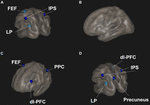Change the Brain to Increase Sustained Attention with Meditation
By John M. de Castro, Ph.D.
“as the popularity of mindfulness grows, brain imaging techniques are revealing that this ancient practice can profoundly change the way different regions of the brain communicate with each other – and therefore how we think – permanently.” – Tom Ireland
There has accumulated a large amount of research demonstrating that meditation practice has significant benefits for psychological, physical, and spiritual wellbeing. One way that meditation practices may produce these benefits is by altering the brain. The nervous system is a dynamic entity, constantly changing and adapting to the environment. It will change size, activity, and connectivity in response to experience. These changes in the brain are called neuroplasticity. Over the last decade neuroscience has been studying the effects of contemplative practices on the brain and has identified neuroplastic changes in widespread areas. In other words, meditation practice appears to mold and change the brain structures and connectivity, producing psychological, physical, and spiritual benefits, especially mindfulness.
In today’s Research News article “Advanced Meditation Alters Resting-State Brain Network Connectivity Correlating With Improved Mindfulness.” (See summary below or view the full text of the study at: https://www.frontiersin.org/articles/10.3389/fpsyg.2021.745344/full?utm_source=F-AAE&utm_medium=EMLF&utm_campaign=MRK_1778822_a0P58000000G0YfEAK_Psycho_20211123_arts_A ) Vishnubhotla and colleagues recruited experienced meditators participating in an 8-day silent residential meditation retreat and a control group who were not participating in the retreat. They were measured before and after the retreat for anxiety, depression, mindfulness, joy, vitality, and resilience and had their brains scanned with functional Magnetic Resonance Imaging (fMRI), at rest and also during focused meditation. They examined the interconnectivity between the default mode network (DMN), salience network (SN), frontoparietal network (FPN), and dorsal attention network (DAN) of the brain.
They found that in comparison to pre-retreat and the control group following the meditation retreat during focused meditation there was a significant reduction in the functional connectivity between the salience network and the default mode network and also between the default mode network, the dorsal attention network, and the frontoparietal network. In addition, they found that after the retreat the greater the increase in the connectivity within the salience network the greater the increase in mindfulness.
The salience network has been shown to direct attention to significant aspects of the environment, dorsal attention network has been shown to be involved in sustained attention, and the frontoparietal network has been shown to be involved in high level thinking, executive function, and also sustained attention while the default mode network has been shown to be involved in self-referential thinking and mind wandering. The reduced functional connectivity between the default mode network and the other 3 suggests that self-referential thinking and mind wandering are less likely to affect the attentional responses and the ability to sustain attention. Hence the results suggest that meditation practice improves the ability to sustain attention in the face of the brains tendency to wander and this becomes stronger after a meditation retreat. These brain network changes appear to parallel the experiential aspects of meditation.
So, change the brain to increase sustained attention with meditation.
“The practice [meditation] appears to have an amazing variety of neurological benefits – from changes in grey matter volume to reduced activity in the “me” centers of the brain to enhanced connectivity between brain regions.” – Aloce Walton
CMCS – Center for Mindfulness and Contemplative Studies
This and other Contemplative Studies posts are available on Twitter @MindfulResearch
Study Summary
Vishnubhotla RV, Radhakrishnan R, Kveraga K, Deardorff R, Ram C, Pawale D, Wu Y-C, Renschler J, Subramaniam B and Sadhasivam S (2021) Advanced Meditation Alters Resting-State Brain Network Connectivity Correlating With Improved Mindfulness. Front. Psychol. 12:745344. doi: 10.3389/fpsyg.2021.745344
Purpose: The purpose of this study was to investigate the effect of an intensive 8-day Samyama meditation program on the brain functional connectivity using resting-state functional MRI (rs-fMRI).
Methods: Thirteen Samyama program participants (meditators) and 4 controls underwent fMRI brain scans before and after the 8-day residential meditation program. Subjects underwent fMRI with a blood oxygen level dependent (BOLD) contrast at rest and during focused breathing. Changes in network connectivity before and after Samyama program were evaluated. In addition, validated psychological metrics were correlated with changes in functional connectivity.
Results: Meditators showed significantly increased network connectivity between the salience network (SN) and default mode network (DMN) after the Samyama program (p < 0.01). Increased connectivity within the SN correlated with an improvement in self-reported mindfulness scores (p < 0.01).
Conclusion: Samyama, an intensive silent meditation program, favorably increased the resting-state functional connectivity between the salience and default mode networks. During focused breath watching, meditators had lower intra-network connectivity in specific networks. Furthermore, increased intra-network connectivity correlated with improved self-reported mindfulness after Samyama.
